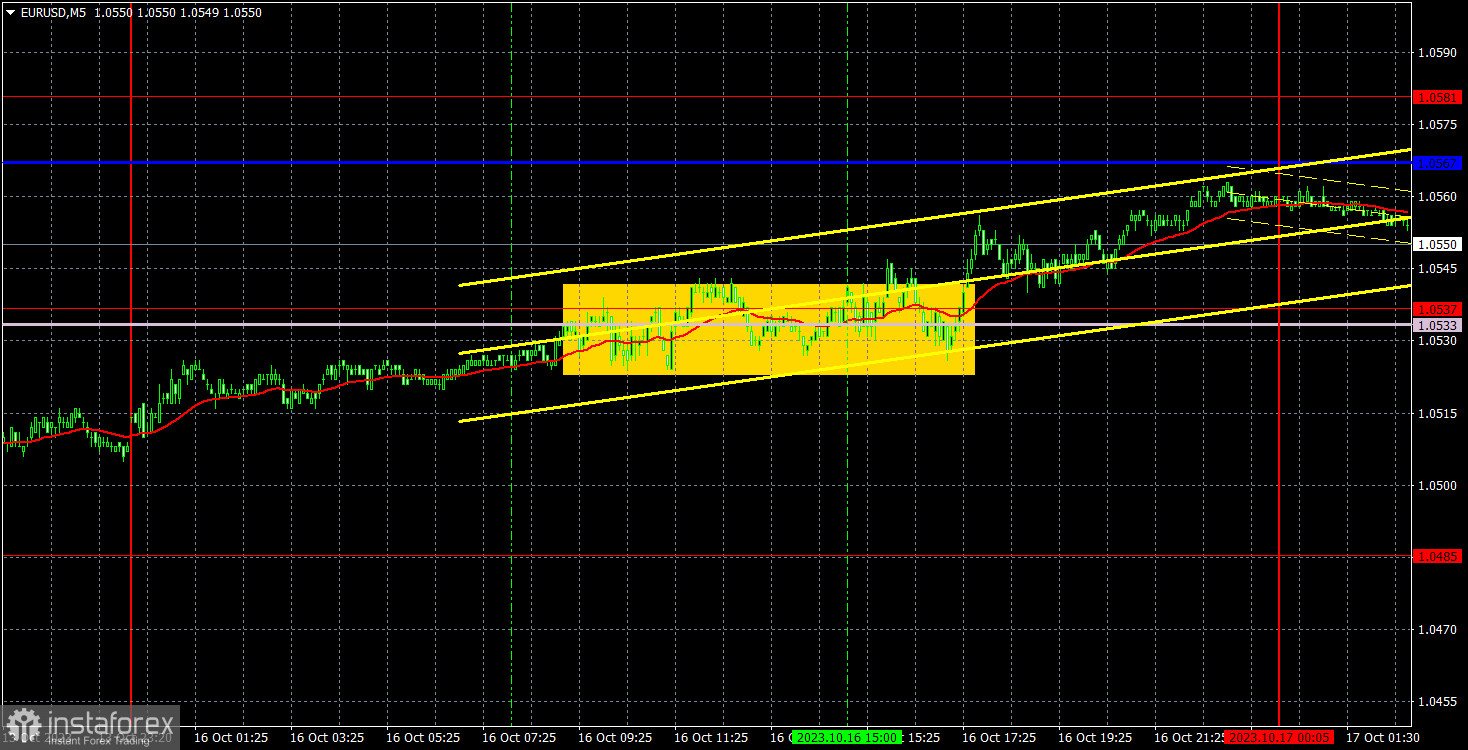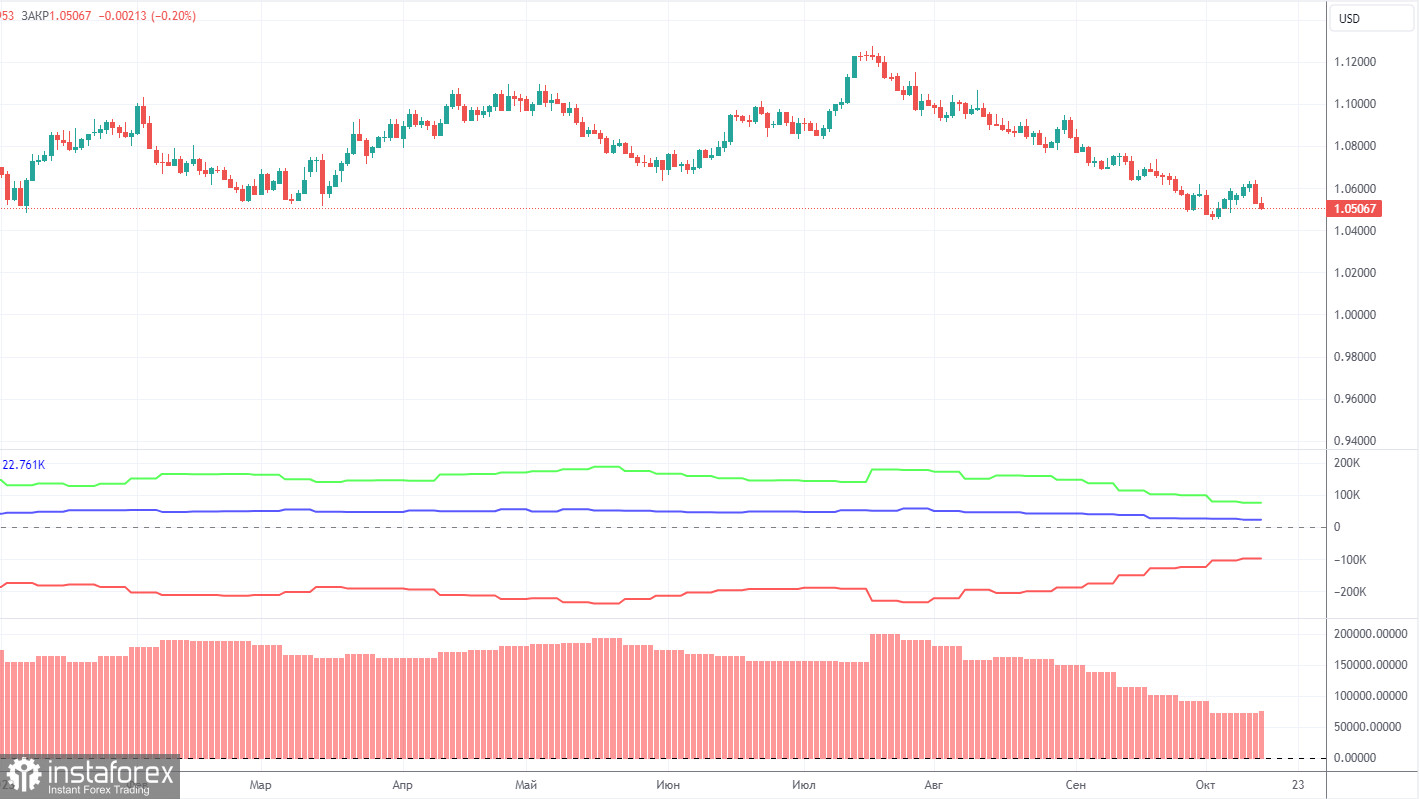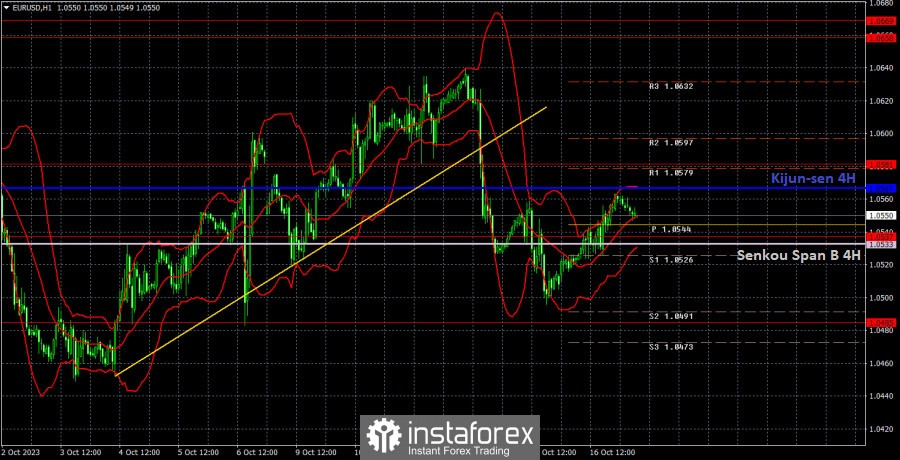Analysis of EUR/USD 5M

EUR/USD started a new corrective phase on Monday. There were no fundamental or macroeconomic reasons for this move. Nevertheless, as we have repeatedly mentioned, we were not satisfied with last week's corrective phase, as it was too small given that the pair had fallen by a total of 800 pips. Therefore, regardless of whether there was a corresponding fundamental background or not, we believe that the pair should start a new corrective phase. Moreover, in this case, the entire correction will take on a classical three-wave pattern. However, yesterday's volatility was quite low, as the pair was unable to move more than 50 pips, and this happened in the absence of economic reports. It was just a typically "dull Monday" with slow but one-sided movement.
Given such market conditions, it doesn't make much sense to highlight specific trading signals. At the beginning of the European session, the price encountered the Senkou Span B line and the level of 1.0537, which it spent a total of about 6 hours trying to overcome. During this time, the price crossed these two lines back and forth about ten times, with fluctuations of 10 pips or so. Overall, this could have been seen as a signal to go long. In this case, long positions could have been opened at the beginning of the US session, but it would have yielded a profit of only 10-15 pips at best.
COT report:

On Friday, a new COT report for October 10th was released. Over the past 12 months, the COT report data has been consistent with what's happening in the market. The net position of large traders (the second indicator) began to rise back in September 2022, roughly at the same time that the euro started to rise. In the first half of 2023, the net position hardly increased, but the euro remained relatively high during this period. Only in the last two months, we have seen a decline in the euro and a drop in the net position, which we've been waiting for a long time. Currently, the net position of non-commercial traders is still bullish and this trend is likely to lose momentum soon.
We have previously noted that the red and green lines have moved significantly apart from each other, which often precedes the end of a trend. This configuration persisted for over half a year, but ultimately, the lines have started moving closer to each other. Therefore, we still stick to the scenario that the upward trend is over. During the last reporting week, the number of long positions for the "non-commercial" group decreased by 4,200, while the number of short positions fell by 800. Consequently, the net position decreased by another 3,400 contracts. The number of BUY contracts is higher than the number of SELL contracts among non-commercial traders by 75,000, but the gap is narrowing. In principle, it is now evident even without COT reports that the euro is set to extend its weakness.
Analysis of EUR/USD 1H

On the 1-hour chart, the pair has overcome both Ichimoku indicator lines, but there's still a high probability of another corrective phase. We believe that the dollar will continue to advance in the medium term, but we still expect a stronger correction in the near future. The pair has already crossed the Senkou Span B line, and now it needs to breach the Kijun-sen line.
On October 17, we highlight the following levels for trading: 1.0269, 1.0340-1.0366, 1.0485, 1.0537, 1.0581, 1.0658-1.0669, 1.0768, 1.0806, 1.0868, 1.0935, as well as the Senkou Span B line (1.0533) and Kijun-sen (1.0567). The Ichimoku indicator lines can shift during the day, so this should be taken into account when identifying trading signals. There are also auxiliary support and resistance levels, but signals are not formed near them. Signals can be "bounces" and "breakouts" of extreme levels and lines. Don't forget to set a breakeven Stop Loss if the price has moved in the right direction by 15 pips. This will protect against potential losses if the signal turns out to be false.
On Tuesday, investors will monitor the ZEW Economic Sentiment Survey for October, and the US Retail Sales and Industrial Production for fresh impetus. All three reports are not highly important, but they could trigger some market reaction. The direction of the movement will depend on the report's values.
Description of the chart:
Support and resistance levels are thick red lines near which the trend may end. They do not provide trading signals;
The Kijun-sen and Senkou Span B lines are the lines of the Ichimoku indicator, plotted to the 1H timeframe from the 4H one. They provide trading signals;
Extreme levels are thin red lines from which the price bounced earlier. They provide trading signals;
Yellow lines are trend lines, trend channels, and any other technical patterns;
Indicator 1 on the COT charts is the net position size for each category of traders;
Indicator 2 on the COT charts is the net position size for the Non-commercial group.





















